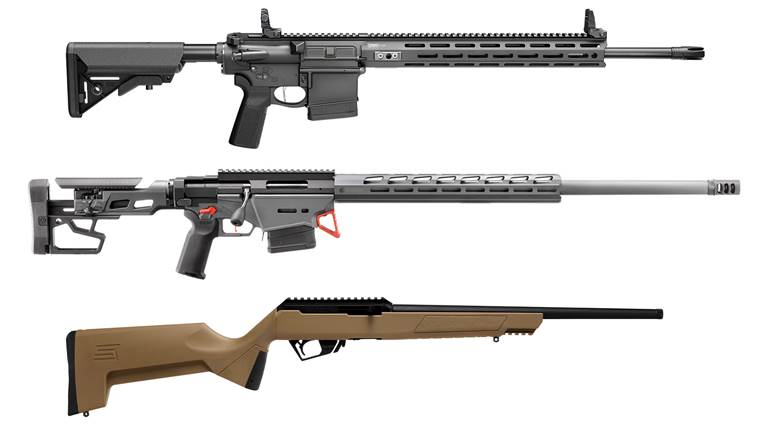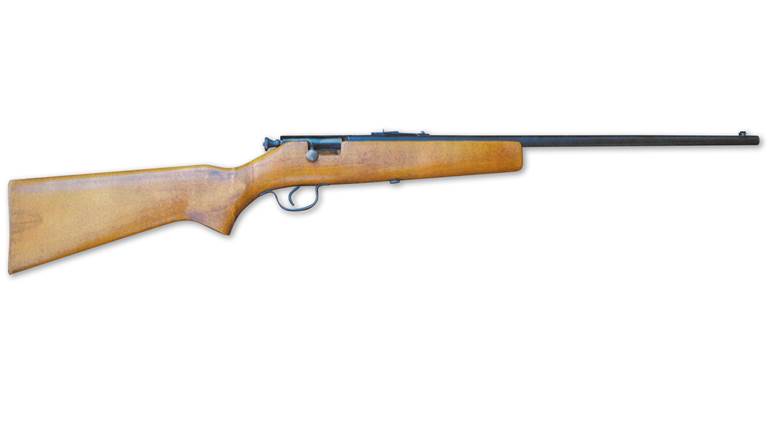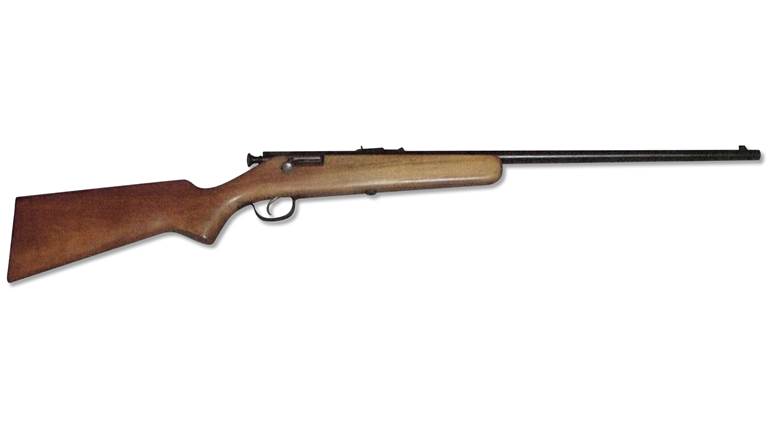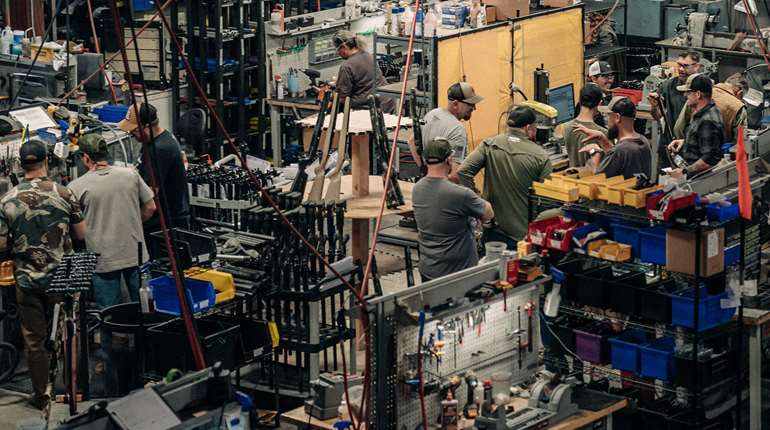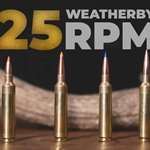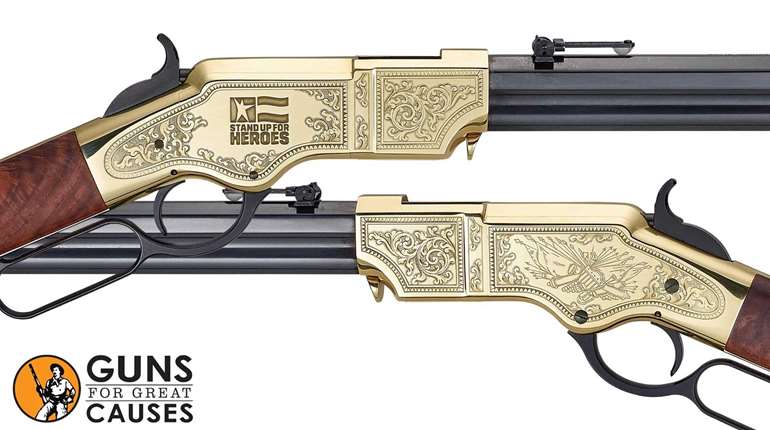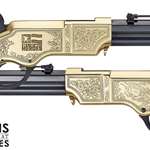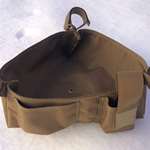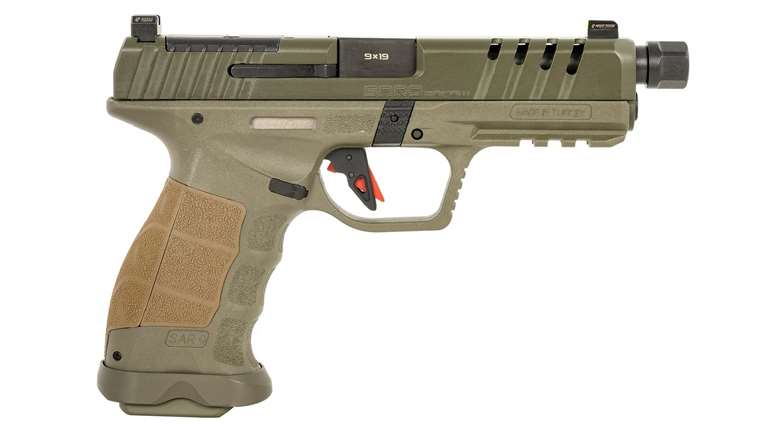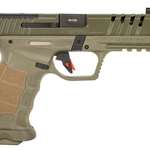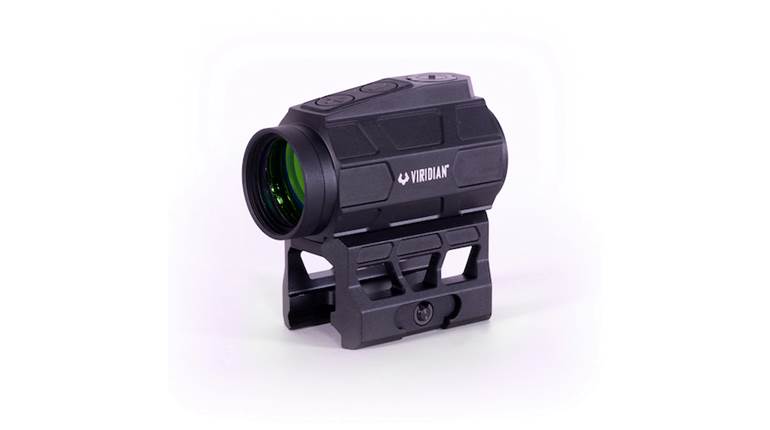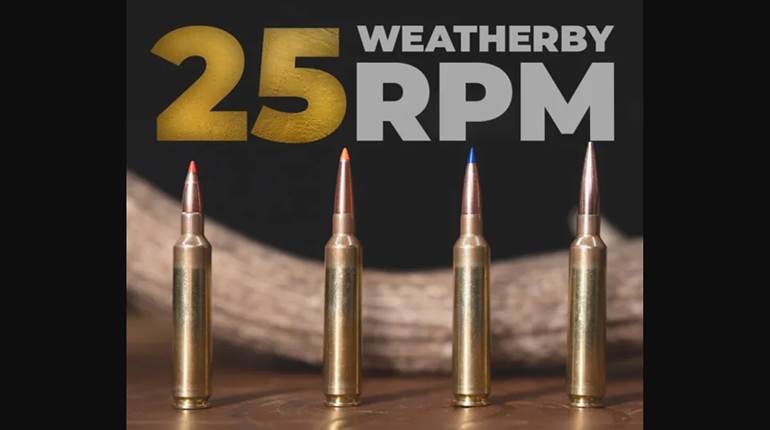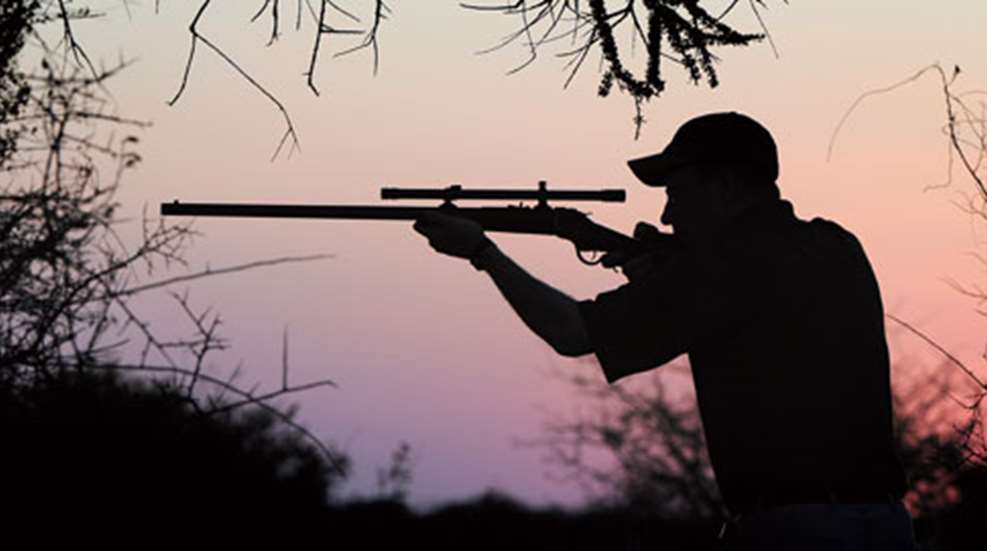
The legendary partnership between John Moses Browning and Winchester Repeating Arms Co. didn’t spring from the genius of America’s greatest gun designer or from the foresight of Winchester’s Vice President and General Manager Thomas G. Bennett. Rather it was patent infringement that put John Moses on the firm’s radar screen. The Browning Bros. store in Morgan, Utah, sold guns (including a “Breech-Loading Fire-Arm” patented on Oct. 7, 1879, by one J.M. Browning), ammunition, and amongst other sundry sporting goods, a line of loading tools. Winchester sales representative Charles Benton purchased one of the Browning Bros. reloading tools and sent it back east. Indeed, it did infringe on patents owned by Winchester, but Benton also had a look at an extremely strong falling-block single-shot design dubbed, simply enough, the Browning Single-Shot. Knowing Winchester was looking for a single-shot that could accept the .45-70 Gov’t cartridge, Benton purchased one (at most 600 were made) in .38 cal. and immediately sent it back to New Haven, Conn., in June 1883. Bennett knew a good thing when he saw it and, according to Herb Houze in “Winchester Repeating Arms Co.: Its History and Development From 1865 To 1981,” put William Mason on the job of defeating Browning’s patent. It couldn’t be done, so Bennett hopped a train to Utah and negotiated the rights to the patent for $8,000, as well as the rights for future Browning designs, including a lever-action that became the Model 1886. Thus started the long and profitable collaboration between Winchester and Browning.
The Winchester Single Shot, after being modified and adapted for factory production, was first offered in late 1885, and eventually in more than 80 chamberings ranging from .22 CB Cap to .577 Eley. It was made in both the original High Wall and Low Wall configurations, and both of those had “thick” and “thin” side versions. The “thick” side followed the lines of the original 1879 Browning design, but in its 1886 catalog Winchester introduced the “thin” side, in which the sides of the receiver were milled flat but the receiver was left raised where the fore-end and buttstock met. This allowed stock interchangeability between thick- and thin-side High Walls. The Low Walls were similar, but had a portion of the receiver sides removed, exposing part of the breechblock, and were generally reserved for lower-powered pistol and carbine cartridges.
The rifles, later known as Model 1885s, were cataloged from 1885 until 1920, and 139,725 were manufactured. Made in numerous variations, the High Wall was used in early NRA long-range matches at Creedmoor and popular pre-World War I Schuetzen matches as well. After a 35-year run, Winchester concluded the single-shot was neither desirable nor profitable. But more than 75 years after it was discontinued, an Italian gunmaker saw potential in the “obsolete” design, as he had time and time again with classic American firearms. That man was Aldo Uberti.
The A. Uberti Story
After attending the Zanardelli gunsmithing school for three years, Aldo Uberti, known as “Renato” to his family, started as a full-time employee with Beretta at the age of 14. Uberti learned drafting and worked in the venerable maker’s tool room designing and fabricating production equipment. After the Nazis took control of northern Italy in 1943, Uberti was arrested and sent to a German concentration camp. Rumor has it he refused to give up others at Beretta—including family members—who supported the partisans rather than the Nazis. After being freed, he returned to work at Beretta and married into the Beretta family.
Uberti left his comfortable job to go into business with Vittorio Gregorelli in the late 1950s. The reasons were twofold: an 1851 Colt Navy revolver and Val Forgett. Forgett, who owned Service Armament Corp. and dealt principally in surplus arms, was trying to make a quick buck or two on the upcoming American Civil War centennial, and he had tried working with firms in France and Belgium to build 2,000 “Yank” and “Reb” Colt 1851 Navy replicas. But it was with Gregorelli and his young partner Uberti that, almost by accident, the three men created the replica gun market. The utilitarian design and frontier aura of the 1851 fascinated the young and talented Italian machinist.
The three first met in 1957, the year Forgett formed Navy Arms, and it took a little while to get the guns rolling off the line. Forgett sweated selling the first 100, but they were gone in a week, followed by more and more orders. In 1959 Uberti bought out his partner, founding A. Uberti S.r.l.
Forgett and Uberti soon found there was an almost insatiable appetite for replica guns. “We found out that people wanted to shoot the guns,” Uberti recalled years later. The next gun was a replica of the solid-frame 1858 Remington, followed by more black-powder Colts. Eventually Patersons, Dragoons, Wells Fargos and virtually every other variation from the Hartford plant were made—along with quite a few it didn’t. Next came the lever-actions, starting with the Model 1866 Winchester in 1966, the 1873 and then the Model 1860 Henry. At the urging of one of the Single Action Shooting Society’s founders, Boyd Davis, Uberti expanded into cartridge revolvers, in particular replicas of the Colt Single Action Army, again in dozens of variations—from Bisleys to Buntlines—as well as 1875 and 1890 Remingtons. In 1995, Uberti made its first replica of the Smith & Wesson Schofield (in .45 Colt or .44-40 Win. no less), and currently there is an extensive line of cartridge conversion guns built on the 1851 Navy, the 1860 Army and the 1858 Remington. Other new models include Model 1871-1872 Open Tops and even replicas of engraved Smith & Wesson No. 3s and Russian revolvers. In addition to the lever guns and revolvers, Uberti recreated big single-shots from the frontier West, including Remington Rolling Blocks and, in 1998, the Model 1885 High Wall, which we’ll get to shortly.
By 1982, Uberti had produced more 1851 Navy and 1860 Army revolvers than Colt, and more 1858 Remingtons than Remington. You can likely add the Paterson, Walker, Henry and Model 1866 to the list. Odds are I missed some, but you get the point. Uberti guns have been imported by many companies through the years, and its parts have been used by others. Aldo Uberti died in 1998, and A. Uberti S.r.l was sold to Beretta Holdings in 1999. From 1999 to 2002, Uberti USA in Lakeville, Conn., run by Aldo’s daughter, Maria, imported Uberti guns into the United States under its own name. Val Forgett died in 2002, and in 2003 importation passed to Stoeger (which was itself acquired by Beretta in 2000) in Accokeek, Md.
The same team that imports Benelli and Stoeger guns, which is separate from Beretta USA, handles importation of Benelli, Stoeger and Uberti. Under Stoeger, the Uberti line has continued to grow, and it now includes replicas of Lightning rifles, the Model 1876 Centennial and the 1883 Burgess. A. Uberti guns imported by Stoeger have a five-year warranty, and repair work is performed by factory-trained gunsmiths using factory parts. The company’s slogan, “Uberti History Repeats Itself” was, back in 1957, a radical concept. Who knew that more than a half-century later, entire disciplines of the shooting sports, including Cowboy Action Shooting and North-South Skirmish Ass’n competition, may not have been as popular—or even possible—if it weren’t for a humble Italian machinist with a passion for making guns of a bygone era.
The Uberti 1885 High Wall
Browning has offered replicas of the Model 1885 High and Low Walls off and on through the years (starting with the B-78 in 1973), and some smaller makers in the United States have and still offer 1885s, but there was room for a more affordable, old-school replica. Aldo Uberti worked on the design, and the first Uberti-made 1885 was imported in 1998. This High Wall is a “thin” side, and its receiver, hammer, lever and block are case-colored with rich grays and browns, with hints of blue.
Like the original, the Uberti 1885 is a falling-block, under-lever rifle with a centrally mounted external hammer. The firing pin is mounted in the block in-line with the center of the chamber, and it is retracted when the action is opened. The block is 0.94-inches wide, 0.73-inches thick and 2.44-inches high at its tallest point. The hammer, lever and block are linked via a pin that passes through a relived section in the block’s underside, although dual lugs engage the vertical recesses in the frame for the entire height of the action.
Externally, it is an extremely faithful replica of the 1885, but Uberti chose to use the later coil spring design with a double-U-shaped, piano-wire spring or mousetrap spring, anchored around the hammer pin to power the hammer. Another coil spring in the front of the action provides tension to keep the action closed and actually assists in closing it. From 1885 to 1910, 1885s used a flat spring, and the coil spring design first appeared in a take-down version in 1910.
The sear is suspended by a pin in the top of the action behind the hammer. Linking the trigger and the sear is the “knock off.” When the trigger is depressed, the knock off—which is tensioned by its own flat spring anchored to the top of the lower tang—pivots to release the sear. There is no separate manual safely, only a half-cock notch.
Pulling downward on the lever, which is pinned to the breechblock, lowers the hammer and block to allow access to the chamber. Unlike the early original guns, which automatically cocked the hammer, the hammer is returned to the half-cock position when the lever is closed, and the hammer must be manually cocked before firing. In order for the hammer to travel fully forward, the trigger must be pulled, as an intercept notch prevents it from contacting the rear of the breechblock-mounted firing pin. There is no ejector, only an extractor at the 9 o’clock position.
The line now includes three models—all come with blued steel barrels and case-colored frames and levers. The Carbine comes with a 28-inch round barrel and a satin walnut straight stock and a shotgun-style steel buttplate. A straight, uncheckered stock and an octagonal barrel, offered in 30 or 32 inches, distinguish the Sporting from the Special Sporting, which has a checkered semi-pistol grip stock and a blued steel crescent buttplate. In the front is a dovetailed blade and in the rear is a buckhorn drift adjustable for windage in its dovetail with a ladder for elevation. A vernier-style rear target sight is offered, as is a hooded front with various inserts.
For sighting, I decided to go “old school” and mounted a replica William Malcolm 18-inch-long, 3/ 4-inch-diameter 6X scope in Malcolm externally adjustable rings. The barrel was drilled and tapped to accept two dovetail bases (see the full story “Old School Glass”).
The stock on my sample .45-70 Gov’t Special Sporting was of straight-grained European walnut finished with a reddish hue with straight, albeit thin grain. The schnabel fore-end with double-diamond checkering in a bordered point pattern is retained by a single screw. The buttstock is mounted to the action via a bolt that passes through the top tang, the stock and into the bottom tang. Another screw passes through the lower tang directly into the stock.
The 30-inch barrel of my Special Sporting was octagonal and measured 1.06 inches across the flats just forward of the receiver and tapered to 0.89 inches at the muzzle. There are six grooves of cut rifling in a 1:18-inch right-hand twist. Obviously, this tube accounts for a lot of the rifle’s weight—10 pounds, 10 ounces with the Malcolm scope in place. Without the optic, the gun weighed 9 pounds, 9 ounces. This is indeed heavy, but put it up to your shoulder and the gun points like a dream. Recoil with standard pressure loads was negligible, so long as I pulled the blued steel crescent butt fully into my shoulder. The addition of the scope required getting my head up, but not so much as to pull it all the way off the stock. I fired the rifle for accuracy with three different factory loads at 100 yards and practiced shooting from various field positions and from shooting sticks. As may be seen in the accompanying table, with Federal’s 300-grain Fusion load in particular, the gun performed extremely well.
Why all the practice? Last year I was invited along to participate in a series of television shows for “Benelli On Assignment” in Botswana’s Okavango Delta and the Kalahari, and the old school 1885 with the Malcolm scope was my primary rifle. We hunted with Rann Safaris in the storied Okavango Delta, in particular near the Kiri Camp, once the stomping grounds of the legendary Harry Selby for more than a half century. It was bittersweet, as that concession is now a photography-only area closed to hunting. The game we took was, at least for now, the last for an area rich in safari tradition and history.
Going Cowboy … In Africa?
In the Okavango, some areas are thick as one might expect, and it is there that the impala of the area thrive. We tried a few stalks without much success through the terrain, which is wooded yet open in some patches. Then we tried another stalk with a pile of dead limbs between us and a fine impala ram. The wind was with us, and there was enough underbrush and downed trees to cover our approach. Professional hunter Jeff Rann, an old Botswana hand who’s operated out of the Okavango for the past 25 years, set the sticks as I rested the buffalo gun (okay, bison numbers were abysmal by 1885) with its Malcolm scope atop it on the sticks, cocked the hammer and settled in with a 300-grain Fusion bonded hollow-point in the chamber. Designed for white-tailed deer, the factory ballistics for the Fusion have it moving out at 1850 fps from the muzzle, delivering 2,820 ft.-lbs. of energy. I settled the crosshair on its shoulder, let out half a breath and squeezed. The rifle bucked on the sticks and I was rewarded with a resounding thump as the impala darted to my right. We found it about 20 yards away with a perfect hole just behind its shoulder, and an even larger one out the off side as the bullet showed excellent expansion, having passed through the vitals of the antelope.
From the waters and grasses of the Okavango Delta, we moved south to hunt gemsbok. After quite a lot of jostling to my scope mount, I switched to the factory sights. Using the 1885 with open sights provided a challenge in Botswana’s Kalahari. Just in case you think your hunt needs more adversity, I highly recommend using an iron-sighted .45-70 Gov’t with 40-something eyes and asking someone to follow you about with a large high-definition camera on a tripod. No matter how good your camera man is, and mine, Randy Wemberg, was excellent, it’s still just that much more scent, movement and noise. After a few blown stalks, professional hunter Murray Hibbs told me, “Mark, we need a plan. We need to get close.”
Literally moments later, we spotted a mature male gemsbok, feeding, and we had the drop on it. We used the wind and the cover of the thick brush to circle around the bull. We came within 80 to 90 yards, but there was too much brush in the way. The oryx was moving slowly, head down, feeding as we moved parallel and closer to him. We set up on the shooting sticks three times before both hunter and cameraman had the shot they wanted. Capturing a hunt on film is different, as not only do you have to be ready, but the cameraman has to be on the animal—the right animal—and ready as well.
We had closed to within 60 yards, were set, and that’s when the bull turned about and started moving back toward us. I could see its entire body and had the front sight planted firmly on the shoulder. All I could see inside the buckhorn was gemsbok hide. He was just slightly below us and there was the dry grass of the Kalahari covering his heart. I eased the front sight up a little to clear it, and began the trigger squeeze. The bullet impacted exactly where I was aiming, and passed completely though. It never took another step.
If there is a cooler “old-school” configuration of replica rifle and scope, I’m not sure what it would be. Merely walking down the hall of the offices with the Uberti on my shoulder created quite a stir. Hunting with it in Botswana linked me with the unlikely posse of Thomas G. Bennett, John Moses Browning, NRA’s founders at Creedmoor, Harry Selby, Robert Ruark and Aldo Uberti. That’s a lot to ask of one rifle, but the 1885 High Wall passed with flying colors, case-colors that is.
Manufacturer: A. Uberti S.p.a.
Importer: A. Uberti; (301) 283-6981; www.uberti.com
Caliber: .45-70 Gov’t (tested), .45-90, .45-120
Action: falling block, center-fire single-shot
Receiver: case-colored steel
Barrel: 32" octagonal, blued steel
Rifling: cut rifling, six-groove, 1:20" RH twist
Sights: windage- and elevation-adjustable open buckhorn rear, windage adjustable front blade
Trigger Pull: single-stage; 3 lbs., 5 ozs.
Stock: European walnut with steel crescent buttplate; length of pull, 141⁄16"; drop at heel, 2¼"; drop at comb, 19⁄16"
Overall Length: 471⁄8"
Weight: 9 lbs., 9 ozs. (10 lbs. 9 ozs. with scope & mounts)
Accessories: owner’s manual,
Suggested Retail Price: $1,179












